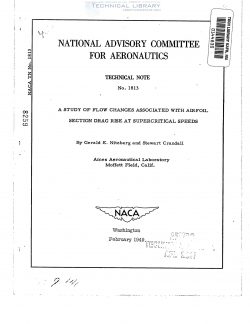naca-tn-1813
- Version
- 50 Downloads
- 1.30 MB File Size
- 1 File Count
- December 8, 2016 Create Date
- December 8, 2016 Last Updated
National Advisory Committee for Aeronautics, Technical Notes - A Study of Flow Changes Associated with Airfoil Section Drag Rise at Supercritical Speeds

A study of experimental pressure distributions and section charac—
teristics for several moderately thick airfoil sections was made. A
correlation appears to exist between the drag—divergence Mach number
and the free—stream Mach number for which sonic velocity occurs at the
airfoil crest, the chordwise station at which the airfoil surface is
tangent to the free—stream direction. It was found that, since the mach
number for which sonic velocity occurs at the airfoil crest can be
estimated satisfactorily by means of the Prandtl—Glauert rule, a method
is provided whereby the drag—divergence Mach number of an airfoil
section at a given angle of attack oan.be estimated from the lowhspeed
pressure distribution and the airfoil profile. This method was used
to predict with a reasonable degree of accuracy the drag—divergence
Mach number of a considerable number of airfoil sections having diverse
shapes and a wide range of thicknesséchord ratios.
The pressure distributions and section force characteristics of
several moderately thick airfoil sections at Mach numbers above the
drag—divergence Mach number were analyzed. Some of the characteristics
of the flow over these airfoils at supercritical Mach numbers are
discussed.
The first intensive efforts to develop airfoil sections suitable
for high—subsonic—speed applications were directed toward Obtaining
sections with the highest possible critical speeds. It was reasoned
that, if the first occurrence of local sonic velocity on the airfoil
surface could be delayed to higher free—stream Mach numbers, then, the
adverse lift and drag changes associated with supercritical speeds
could be delayed. However, experimental measurements show that the
onset of these adverse effects is not directly related to the
critical Mach number. For some types of airfoil sections the drag
rises rapidly as soon as the free-stream Mach number exceeds the
critical; whereas for other types no appreciable drag rise occurs
until the Mach mmber of the free stream is considerably above the
critical.
| File | Action |
|---|---|
| naca-tn-1813 A Study of Flow Changes Associated with Airfoil Section Drag Rise at Supercritical Speeds.pdf | Download |
Comment On This Post